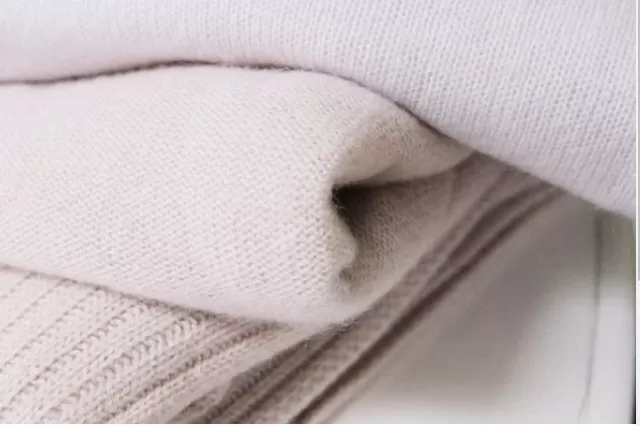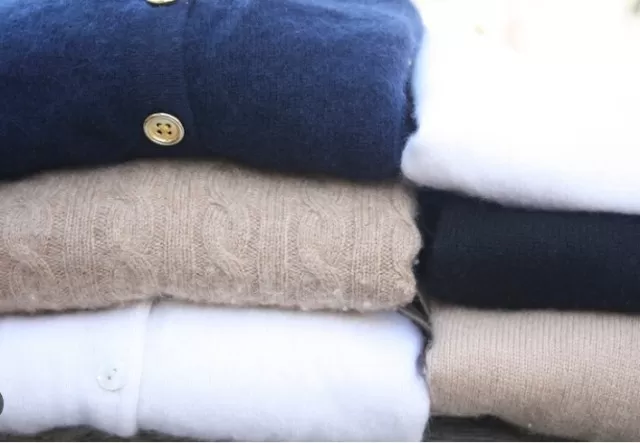Skip Dry Cleaners: Care for Cashmere & Wool. Debunking the myth: Your sweaters, including cashmere and wool, do not always require dry cleaning. With proper care, you can wash them at home and preserve their quality.
Many people hesitate to wash their sweaters at home due to past laundry mishaps, such as accidentally shrinking a beloved wooly favorite in the dryer. However, with careful attention, there’s no need to rely solely on dry cleaners.
Sweater Care: How Often to Wash Wool and Cashmere

When it comes to washing wool and cashmere sweaters, following the right frequency is crucial to preserve their quality.
While personal preferences may vary, it is generally not recommended to wash or dry clean these sweaters after every use. Here are some guidelines to help determine how often you should wash your sweaters:.
Consider the rotation: If you have a pile of sweaters in your closet that you don’t wear frequently, it is ideal to wash them once or twice a season.
This approach is suggested by Gwen Whiting of The Laundress, an expert in fabric care.
Beginning and end of the season: A good practice is to launder your wool and cashmere sweaters at the start and end of each season.
This helps maintain freshness and cleanliness while avoiding excessive washing that can potentially damage the delicate yarns.
Assess individual needs: Pay attention to each sweater’s condition and usage.
Sweaters worn more frequently or exposed to stains or odors may require more frequent washing. Use your discretion based on the specific care requirements of each garment.
Washing Guide for Wool and Cashmere Sweaters
To effectively wash wool and cashmere sweaters, the following steps can be applied to various types of animal fibers, including sheep, alpaca, mohair, lamb, merino, and camel.
Gwen Whiting of The Laundress suggests using the same cleaning process for these materials:.
Read the care instructions: Check the care label on your sweater for specific washing instructions and any recommended temperature settings.
Pre-treat stains: Before washing, spot treat any stains or spills using a gentle detergent or stain remover formulated for delicate fabrics.
Follow the product instructions and test on a small, inconspicuous area first.
Fill a basin or sink: Fill a clean basin or sink with lukewarm water.
Add a small amount of gentle detergent specifically designed for wool or cashmere.
Submerge and soak: Submerge the sweater in the water and gently press it down to ensure it is fully immersed.
Let it soak for about 10 to 15 minutes to loosen dirt and oils.
Gently agitate: Gently swirl or agitate the sweater in the water to further loosen dirt.
Avoid any harsh rubbing or wringing, as this can cause damage.
Rinse thoroughly: Drain the Soapy Water and refill the basin or sink with clean lukewarm water.
Rinse the sweater by gently pressing and agitating it in the water to remove any remaining detergent.
Squeeze out excess water: Carefully lift the sweater out of the water and gently squeeze out the excess water.
Avoid twisting or wringing, as this can distort the shape of the sweater.
Reshape and dry flat: Lay a clean, dry towel on a flat surface and place the sweater on top.
Reshape the sweater to its original size and dimensions. Allow it to air dry away from direct sunlight or heat sources.
Pre-Washing Step: Measure Your Sweater

Before washing your sweater, it is essential to measure its original dimensions to ensure proper care and maintenance.
Martha Stewart, renowned lifestyle expert, emphasizes the importance of measuring your sweater before cleaning to help it regain its original shape. Here’s how you can measure your sweater:.
Gather your supplies: Grab a tape measure and a pen and paper to record the measurements.
Measure the length: Start by measuring the overall length of the sweater, from the top shoulder seam to the bottom hem.
This will give you an idea of the sweater’s total length.
Measure the sleeves: Measure the length of each sleeve from the armpit down to the base of the sweater.
This will help you maintain the original sleeve length during the washing process.
Measure the openings: Measure the width of the head opening (neckline) and hand openings (cuffs).
This will ensure that these areas maintain their original size and fit.
Record the measurements: Write down the measurements you’ve taken, noting the length, sleeve length, and opening widths.
This will serve as a reference point for comparing the sweater’s dimensions after washing.
Hand Washing Steps for Sweaters
To ensure the safe cleaning of your sweaters, it is recommended to follow the hand washing method.
Gwen Whiting provides the following steps:.
Fill a sink or basin with cold water: Prepare a sink or basin with cold water, avoiding extremely cold temperatures.
It’s important to maintain the water’s coolness to prevent potential shrinkage or damage to the fibers.
Add a suitable cleanser: Use a cleanser specially formulated for wool or cashmere.
If you don’t have one, a gentle hair shampoo can be an alternative. Remember that wool and cashmere are natural hair fibers.
Submerge the sweater: Place the sweater into the water, taking care to separate colors.
Keep beige and white garments separate from any colored items to avoid color bleeding.
Gently swirl and soak: Swirl the sweater gently in the water for about 30 seconds to allow the cleanser to penetrate the fibers.
Then, let the sweater soak for up to 30 minutes, allowing the soap to work its magic.
Rinse with cold water: Drain the soapy water and rinse the sweater thoroughly with cool, clean water from the faucet.
Rinse until the water runs clear, ensuring all soap residue is removed.
Drain and gently press out excess water: Carefully lift the sweater out of the sink or basin and gently press it against the side to remove excess water.
Avoid twisting or wringing, as this can damage the fibers.
Reshape and dry flat: Lay a clean, dry towel on a flat surface and place the sweater on top.
Reshape the sweater to its original size and dimensions. Allow it to air dry away from direct sunlight or heat sources.
Flip the sweater halfway through the drying process to ensure even drying.
Machine Washing Tips for Sweaters

While hand washing is preferred, you can also safely wash your sweaters in a washing machine by following these guidelines:.
Use a mesh washing bag: Place your sweater inside a mesh washing bag before putting it in the machine.
This helps protect the garment from excessive agitation and prevents it from getting tangled or stretched.
Select the delicate cycle: Choose the delicate or gentle cycle on your washing machine.
This cycle is specifically designed for delicate fabrics and provides a slower and gentler wash.
Cold water and low spin: Set the water temperature to cold and the spin cycle to low.
Cold water helps prevent shrinking or felting of the fibers, while a low spin minimizes excessive agitation.
Avoid overloading: Do not overcrowd the machine.
Make sure there is enough space for the sweater to move freely and for water and detergent to circulate effectively.
Use a mild detergent: Use a mild detergent suitable for delicate fabrics.
Avoid using harsh detergents or bleach, as they can damage the fibers.
Promptly remove after washing: Once the washing cycle is complete, promptly remove the sweater from the machine to minimize creasing.
Do not leave it sitting in the machine for an extended period.
Reshape and air dry: Gently reshape the sweater to its original size and dimensions.
Lay it flat on a clean towel or drying rack to air dry. Avoid hanging the sweater, as this can cause stretching.
Proper Drying Techniques for Sweaters

To preserve the shape and integrity of your sweaters, it’s important to follow the correct drying methods.
Avoid using a dryer or wringing out the sweater by hand, as these actions can damage the fibers. Here’s how to properly dry your sweaters:.
Squeeze out excess water: After washing, gently squeeze out the excess water from the sweater.
Avoid wringing or twisting, as this can distort the shape and weaken the fibers. Instead, press the sweater into a ball to remove as much water as possible.
Prepare a dry towel: Lay out a clean, dry towel on a flat surface.
The towel should be large enough to accommodate the sweater’s size.
Reshape the sweater: Place the damp sweater onto the dry towel and gently manipulate it to conform to its original shape.
Use the measurements you wrote down earlier to ensure proper sizing and dimensions.
Fold and roll: Fold the towel over the sweater, covering it completely.
Starting from one end, roll the towel with the sweater inside, applying gentle pressure to remove additional moisture. Rolling the towel helps absorb excess water from the sweater.
*The information is for reference only.